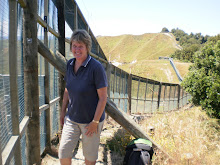


It was a wonderful way to end my time on the PTSF by having a trip out to Tiritiri Island in the Hauraki Gulf during the July school holidays. The hours boat trip was enjoyable but the abundance of birdlife on the island was incredible.Within 5 minutes we saw many saddlebacks scratching in the sand finding tasty treats. Then a friendly N.I. robin hopped amongst our feet as we sat,listened and watched in the bush. Three takahe grazed out in the open and the tui feeder at the visitors centre was absolutely overloaded with tui! Another highlight were the huge number of stitchbirds and bellbirds at their feeders as we walked along the walkways. The fabulous views and great weather all helped make this a truely memorable day.



















 Bushy Park is approx 30 minutes out of Wanganui.
Bushy Park is approx 30 minutes out of Wanganui.




















